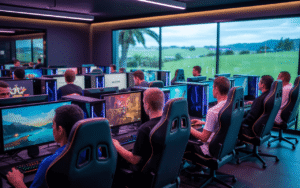Local connections are still the actual glue, even though global networks give the impression that everyone is only a click away. Even if we trade messages across continents and skim through digital feeds, the true spark of growth still originates from people who cross paths, exchange ideas, and start things moving.
Places where local creativity and international cooperation collide make this evident. Big ideas don’t just happen. They take shape in coffee shops, shared workspaces, and community meetups before they ever hit the world stage.
For all our talk about “borderless” innovation, the truth is the local scene keeps the global machine running. It’s the testing ground, the heartbeat, the part that doesn’t make headlines but keeps everything else alive. Because without those roots — the ones that hold communities steady — all that global noise just drifts into the void.
The Local-to-Global Equation
Every movement starts with a small group of people experimenting. Local hubs act as that first spark. They’re the spaces where trial and error happen fast, where people actually know the users they’re building for, and where momentum quietly starts to snowball.
Technology didn’t erase that; it magnified it. In crypto, for instance, the “decentralized” dream still depends on very human networks — people helping people, often within their own neighborhoods.
Across the United States, community-level crypto adoption reflects this same dynamic, where regional access points drive global participation. For example, ByteFederal lists trusted Bitcoin ATMs in Texas, giving users tangible entryways into a vast decentralized ecosystem while keeping transactions rooted in local experience.
It’s funny how the future of finance feels more personal now. The closer innovation stays to real communities, the more powerful it becomes when it scales.
Why Local Hubs Outperform Centralized Giants in Agility
Large organizations can feel like cruise ships. It’s solid and impressive, but it takes forever to turn around. Local hubs, on the other hand, are the speedboats in the harbor — nimble, scrappy, and always moving.
When the world shifted overnight in recent years, it wasn’t the giants that adapted first. It was the small teams, the neighborhood businesses, the co-ops that just rolled up their sleeves and figured things out. They didn’t need a meeting to approve a meeting. They just acted.
Local hubs are highly effective because they detect change before anyone sends out a memo about it. They see it in their communities. They hear it in casual conversations and experience it immediately. Local hubs offer guidance. Global networks offer reach, preventing progress from devolving into anarchy.
The Emotional Economy
You can digitize just about everything, but trust still needs the human touch. Local hubs thrive on relationships that algorithms can’t quite capture — the nods, the shared jokes, the “you’re good for it” moments that technology hasn’t managed to clone.
Instead of dealing with impersonal systems, people prefer to interact with other people. Some people still choose the local store that knows them by name over an upscale online retailer. Because loyalty doesn’t come from convenience alone; it comes from connection.
Sure, reviews and blockchain verification help, but they’re not the same as knowing who’s on the other end. The emotional economy proves that communities with stronger human ties survive change better.
Global networks can move data faster, but local hubs move trust faster. When you think about it, that’s the real currency keeping the world running smoothly.
When Local Meets Tech: The Modern Hybrid Model
What’s happening now is a kind of partnership — technology lending wings to local knowledge. A coder in a quiet town can now work for a company across the world, while a café down the street might start accepting digital payments from tourists.
The point isn’t to replace the local. It’s to give it a louder voice. These connections create a loop: local insights shape global ideas, and international tools empower local change. It’s less about big versus small and more about both sides pulling together.
The world is now accessible because of technology, while local centers remain relatable. They show that no matter how virtual life gets, humans still keep it alive. Someone codes. Someone fixes, and someone makes sure the coffee is hot.
Because it strikes a balance between hardware and heart, the hybrid approach is practical. Ironically, it keeps things human. This is precisely what the digital world needs more of.
The Ripple Effect: How Local Hubs Future-Proof the Global System
The global system becomes more stable when local ecosystems flourish. It’s like having a thousand tiny backup generators. If one fails, the others keep running. Diversity of ideas and geography strengthens networks.
Local hubs also notice what the world’s most prominent players miss. They see firsthand how trends hit communities, how climate change affects small businesses, and how technology actually plays out in real life. That kind of feedback keeps innovation grounded.
Before larger systems take on, it’s frequently these little areas that try new things, including micro-entrepreneurship and sustainable energy projects. Their concepts spread and influence larger movements.
The irony? The more connected the world becomes, the more vital these small-scale networks are. The World Wide Web still needs neighborhood Wi-Fi because without it, the signal fades fast.

Conclusion: The Future Belongs to the Connected Local
Real innovation won’t just come from conference tables. It will grow from neighborhoods where ideas and people are already in motion. It’s the local hubs that understand their people, move quickly, and stay human.
They’re rewriting the playbook for what “global” means. Impact that begins small and expands far is now more important than scale for scale’s sake. Global systems remain adaptable, intimate, and significant when local centers flourish.
The most potent advantage in an era when automation and algorithms are the talk of the town is connectivity, not speed or size. A networked local community can perceive and adapt. It can also care for one another in ways that machines cannot.
The future will belong to those who maintain relationships with both their local communities and the outside world. Real development is based, shared, and constructed one community at a time.










